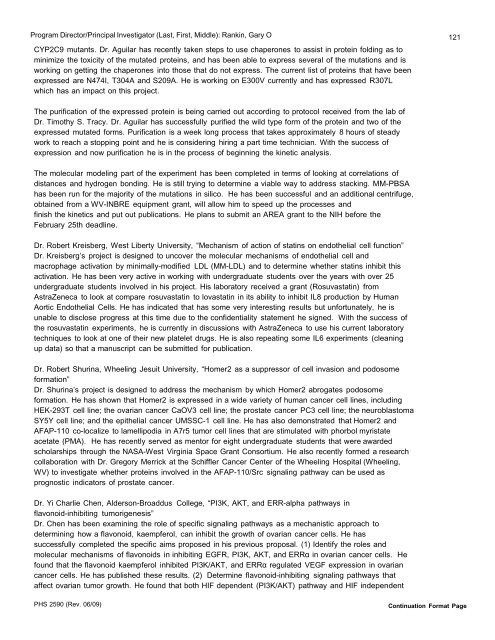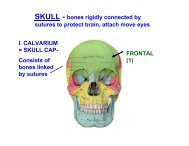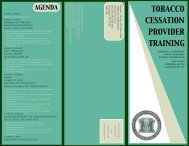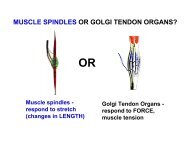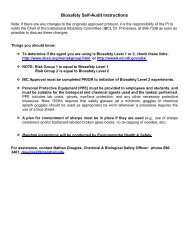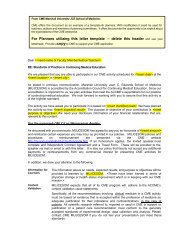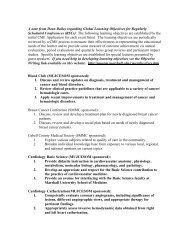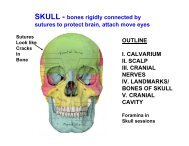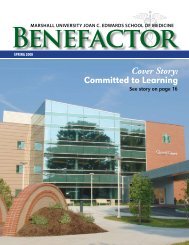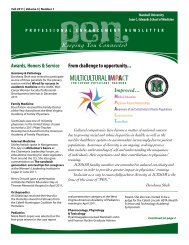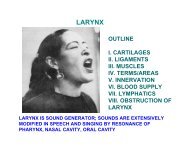FA 5 Progress Report WV-INBRE - Joan C. Edwards School of ...
FA 5 Progress Report WV-INBRE - Joan C. Edwards School of ...
FA 5 Progress Report WV-INBRE - Joan C. Edwards School of ...
- No tags were found...
Create successful ePaper yourself
Turn your PDF publications into a flip-book with our unique Google optimized e-Paper software.
Program Director/Principal Investigator (Last, First, Middle): Rankin, Gary O 121CYP2C9 mutants. Dr. Aguilar has recently taken steps to use chaperones to assist in protein folding as tominimize the toxicity <strong>of</strong> the mutated proteins, and has been able to express several <strong>of</strong> the mutations and isworking on getting the chaperones into those that do not express. The current list <strong>of</strong> proteins that have beenexpressed are N474I, T304A and S209A. He is working on E300V currently and has expressed R307Lwhich has an impact on this project.The purification <strong>of</strong> the expressed protein is being carried out according to protocol received from the lab <strong>of</strong>Dr. Timothy S. Tracy. Dr. Aguilar has successfully purified the wild type form <strong>of</strong> the protein and two <strong>of</strong> theexpressed mutated forms. Purification is a week long process that takes approximately 8 hours <strong>of</strong> steadywork to reach a stopping point and he is considering hiring a part time technician. With the success <strong>of</strong>expression and now purification he is in the process <strong>of</strong> beginning the kinetic analysis.The molecular modeling part <strong>of</strong> the experiment has been completed in terms <strong>of</strong> looking at correlations <strong>of</strong>distances and hydrogen bonding. He is still trying to determine a viable way to address stacking. MM-PBSAhas been run for the majority <strong>of</strong> the mutations in silico. He has been successful and an additional centrifuge,obtained from a <strong>WV</strong>-<strong>INBRE</strong> equipment grant, will allow him to speed up the processes andfinish the kinetics and put out publications. He plans to submit an AREA grant to the NIH before theFebruary 25th deadline.Dr. Robert Kreisberg, West Liberty University, “Mechanism <strong>of</strong> action <strong>of</strong> statins on endothelial cell function”Dr. Kreisberg’s project is designed to uncover the molecular mechanisms <strong>of</strong> endothelial cell andmacrophage activation by minimally-modified LDL (MM-LDL) and to determine whether statins inhibit thisactivation. He has been very active in working with undergraduate students over the years with over 25undergraduate students involved in his project. His laboratory received a grant (Rosuvastatin) fromAstraZeneca to look at compare rosuvastatin to lovastatin in its ability to inhibit IL8 production by HumanAortic Endothelial Cells. He has indicated that has some very interesting results but unfortunately, he isunable to disclose progress at this time due to the confidentiality statement he signed. With the success <strong>of</strong>the rosuvastatin experiments, he is currently in discussions with AstraZeneca to use his current laboratorytechniques to look at one <strong>of</strong> their new platelet drugs. He is also repeating some IL6 experiments (cleaningup data) so that a manuscript can be submitted for publication.Dr. Robert Shurina, Wheeling Jesuit University, “Homer2 as a suppressor <strong>of</strong> cell invasion and podosomeformation”Dr. Shurina’s project is designed to address the mechanism by which Homer2 abrogates podosomeformation. He has shown that Homer2 is expressed in a wide variety <strong>of</strong> human cancer cell lines, includingHEK-293T cell line; the ovarian cancer CaOV3 cell line; the prostate cancer PC3 cell line; the neuroblastomaSY5Y cell line; and the epithelial cancer UMSSC-1 cell line. He has also demonstrated that Homer2 andA<strong>FA</strong>P-110 co-localize to lamellipodia in A7r5 tumor cell lines that are stimulated with phorbol myristateacetate (PMA). He has recently served as mentor for eight undergraduate students that were awardedscholarships through the NASA-West Virginia Space Grant Consortium. He also recently formed a researchcollaboration with Dr. Gregory Merrick at the Schiffler Cancer Center <strong>of</strong> the Wheeling Hospital (Wheeling,<strong>WV</strong>) to investigate whether proteins involved in the A<strong>FA</strong>P-110/Src signaling pathway can be used asprognostic indicators <strong>of</strong> prostate cancer.Dr. Yi Charlie Chen, Alderson-Broaddus College, “PI3K, AKT, and ERR-alpha pathways inflavonoid-inhibiting tumorigenesis”Dr. Chen has been examining the role <strong>of</strong> specific signaling pathways as a mechanistic approach todetermining how a flavonoid, kaempferol, can inhibit the growth <strong>of</strong> ovarian cancer cells. He hassuccessfully completed the specific aims proposed in his previous proposal. (1) Identify the roles andmolecular mechanisms <strong>of</strong> flavonoids in inhibiting EGFR, PI3K, AKT, and ERRα in ovarian cancer cells. Hefound that the flavonoid kaempferol inhibited PI3K/AKT, and ERRα regulated VEGF expression in ovariancancer cells. He has published these results. (2) Determine flavonoid-inhibiting signaling pathways thataffect ovarian tumor growth. He found that both HIF dependent (PI3K/AKT) pathway and HIF independentPHS 2590 (Rev. 06/09)Continuation Format Page


